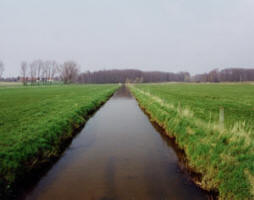 Do smaller water footprints lead to bigger profits?
Do smaller water footprints lead to bigger profits?
Water scarcity and shortage
Water scarcity results when demand exceeds supply. Increases in demand come from increases in population, eating meat and foods that take more water to produce, greater consumption of products that take water to produce, and other factors. Falling supplies can result from pollution, regulations that require more water for the environment, past depletion of "fossil" water resources, and changes in flows resulting from fluctuations in weather or the impacts of climate change.
Scarcity leads to shortage when water managers fail to balance supply and demand. In other words, Nature makes a drought, but Man makes a shortage.
In recent years, we have experienced shortages in food, oil, natural gas, building materials, and other commodities. These shortages were usually caused by political or economic shocks and persisted until prices, markets or regulations reduced demand or increased supply. Water in most countries is allocated and priced according to political and regulatory rules, not markets. This means, for example, that farmers do not buy water in spot markets, groundwater depletion may be subsidized, and a homeowner in a suburban desert may pay less for water than his equivalent in a damp metropolis. In these cases, water is not priced to reflect scarcity.
Consider Los Angeles, the second-largest city in the US and centre of an urban sprawl inhabited by over 20 million people in arid southern California. Los Angeles get some of their water from local sources, but about half of their water is imported from hundreds of miles away. The price they pay for their water reflects the cost of transport, treatment and infrastructure, but it does not reflect the scarcity or value of water. In other words, people in Los Angeles, like people in most parts of the world, pay for delivery but get their water for free. That means that Los Angeles tend to use more cheap water. It also means that they can find themselves staring at a dry tap, perfectly willing to pay the posted price for water that isn't there.
It's easy for us to see what's going on here. We'd have shortages of single-malt whisky if people only had to pay for the bottle and shipping, but we don't because we also have to pay for the whisky. Why isn't the same true for water? The main reason is that we had plenty of water in the past. It was so abundant that we could give it away, only charging for delivery. Today's scarce water is worth more than zero, but water managers and politicians are not used to charging for that scarcity. That needs to change.
Footprinting and disclosure
So why are businesses disclosing their water footprints and risk of water shortage? Why are they spending resources on measuring liters of water per kg of coffee, liter of cola, or hour of lighting?
Perhaps these reports increase profits by helping companies lower their water costs or increase production efficiency. In this case, footprinting should be an old idea. Perhaps they are engaging in good Corporate Social Responsibility (CSR), attempting to inform the world of their use of resources. Or maybe they are doing bad CSR as they greenwash unsustainable behavior with glossy reports, so that consumers can buy guilt-free. Finally, they may be footprinting because they dare not address the real problem - political and bureaucratic mismanagement of water.
A company that operates in India, Brazil, Egypt or Britain alongside hundreds of other companies may not be equipped to lobby governments and regulators for water management that's sustainable or prices that reflect scarcity. That company may prefer to take the water before it runs out, while monitoring for shortage risk. It may not want to stick its neck out, for fear of losing its operating permit or working for change that benefits rivals but costs it dearly.
It's no accident that the leading proponents of water footprinting and disclosure are the same people and organizations that pioneered carbon footprinting and disclosure. In both cases, companies may see reporting as easier than addressing the political root of the problem. But water is different: it's local. And that means that it's much easier to get good water management instead of wasting resources on reports and footprints. Compare India and Denmark. Both are stuck with the global lack of progress in addressing carbon, but India's disastrous water mismanagement does not prevent Denmark from managing its water for safety, sustainability and reliability.
My point is that individual firms may find it profitable in the short run to spend small money on useless water footprint reporting, but suffer in the long run, as water shortages increase and profits drop.
From footprints to marathons
What should they do? The Extractive Industries Transparency Initiative (EITI) provides a useful clue. EITI publishes information on revenues paid to countries for their natural resources. This information makes it harder for these countries to mismanage their resources or waste those revenues. Businesses that use water could support a Hydrated Industries Transparency Initiative to highlight water scarcity, pricing and sustainability, to encourage countries and localities to target sustainable water management. Then those companies can continue to operate - providing products to consumers, revenues to water authorities, and profits to investors - far into the future.
Let's concentrate on the causes of water shortages - mismanagement - instead of wasting resources lamenting the effects of mismanagement.
| Contact information |
David Zetland, The Guardian - David Zetland is an economist who blogs at aguanomics and the author of the forthcoming book, The End of Abundance: Your guide to the new economics of water scarcity. He will be speaking on these topics at the Water and Business Conference that takes place on December 8-9 in London.
|
|---|---|
| News type | Inbrief |
| File link |
http://www.cc2010.mx/es/sala-de-prensa/recursos-para-prensa/news_2010112441783.htm |
| Source of information | The Guardian, UK |
| Keyword(s) | water footprints, water shortage, water scarcity, drought |
| Subject(s) | HYDRAULICS - HYDROLOGY , POLICY-WATER POLICY AND WATER MANAGEMENT , RISKS AND CLIMATOLOGY , WATER DEMAND |
| Relation | http://www.cc2010.mx/ |
| Geographical coverage | n/a |
| News date | 08/12/2010 |
| Working language(s) | ENGLISH |
 you are not logged in
you are not logged in





